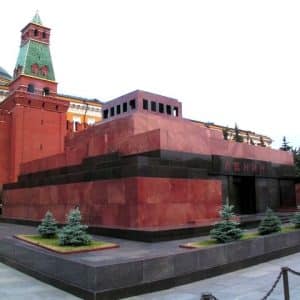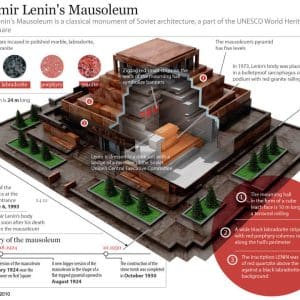Lenin’s Mausoleum/Мавзолей В.И. Ленина
Красная площадь, Moscow
Open Daily 10:00 am-1:00pm
Closed Fridays and Holidays
Admission is Free
Lenin.ru
Vladimir Illyich Lenin is a giant of recent Russian History. Outsiders attempt to describe his meaning among Russians using spiritual leaders, historical figures, and mythology, and always these comparisons seem insufficient.
Father of the revolution, champion of the working classes, he modernized, electrified, and set Russia on the path to socialism. He died at the peak of his popularity, ensuring that his symbolic importance would only increase.
Many of the structures of soviet symbolism are on display with the Lenin Mausoleum. Early soviet culture gave rise to constant comparisons with Ancient Egypt (See “Stalin as Isis and Ra: Socialist Realism and the Art of Design” by John E Bowlt, The Journal of Decorative and Propoganda Arts Vol 24 “Design, Culture, Identity” if you are interested in the subject). Soviets, like Egyptians, exalted the sun (which was a central theme in ancient Slavic folklore), and gave careful consideration to light in their artworks. Egyptians believed they had conquered nature by harnessing water in the desert, so too, Soviet Russia’s early efforts centered on harnessing hydroelectric power. The Egyptians believed that the embalming process gave humans immortality, victory over natural death. Lenin, similarly, seems to live on in the center of Moscow. Most Russians are still familiar with the Soviet matra of “Ленин жил, Ленин жив, Ленин будет жить” (Lenin lived, Lenin lives, Lenin will live).
In this context, many of the aspects of Lenin’s Mausoleum can be better understood. The architect Aleksey Shchusev incorporated the structure of the Step Pyramid of Djoser in his design, using shapes and architecture to indicate the importance of the dead man, and to aid in his journey to the afterlife. The preservation of Lenin is an example of science conquering nature, and has given a certain air of immortality of his symbol.
Nearly every year there is a renewed debate about whether Lenin should be finally put to rest in a burial plot, or be buried by the Kremlin wall, like Stalin. So far there doesn’t seem to be any united will among citizens to make the change. In fact, the preservation is actually funded through private donations.
Visiting Lenin’s Mausoleum is a glimpse into Soviet iconography in the modern world. It may be the most significant historical monument you see in Russia. It’s a step in the direction of understanding his importance, and the reverence with which Russians view him.
Visiting the Mausoleum:
It is advised to dress conservatively at the mausoleum. Male visitors are expected to remove their hats before entering. Talking is prohibited inside the chamber, as are photography or videography of any kind. In fact, try to arrive without cameras or any large bag (women’s purses are generally ok). You may be required to check any camera or bag near the entrance before being allowed to enter. Checking your things often takes considerably longer than waiting in line to pass through the first security barrier. You will be ushered past at a somewhat slow pace, but you cannot pause inside the chamber. The line forms away from the entrance, stretching past he the giant, red Natural History Museum and extending toward Alexandrevsky Sad and the Okhotnyi Ryad shopping center. If you’re not sure where to queue, either ask, or go to the entrance itself to see where people are coming from. Don’t be intimidated by a long line, it goes very fast, and is well regulated.
More at:
Info: www.aha.ru/~mausoleu/
Virtual Tour: lenin.ru
See a tribute video: www.youtube.com/watch?v=JeWK5iRp0BE










